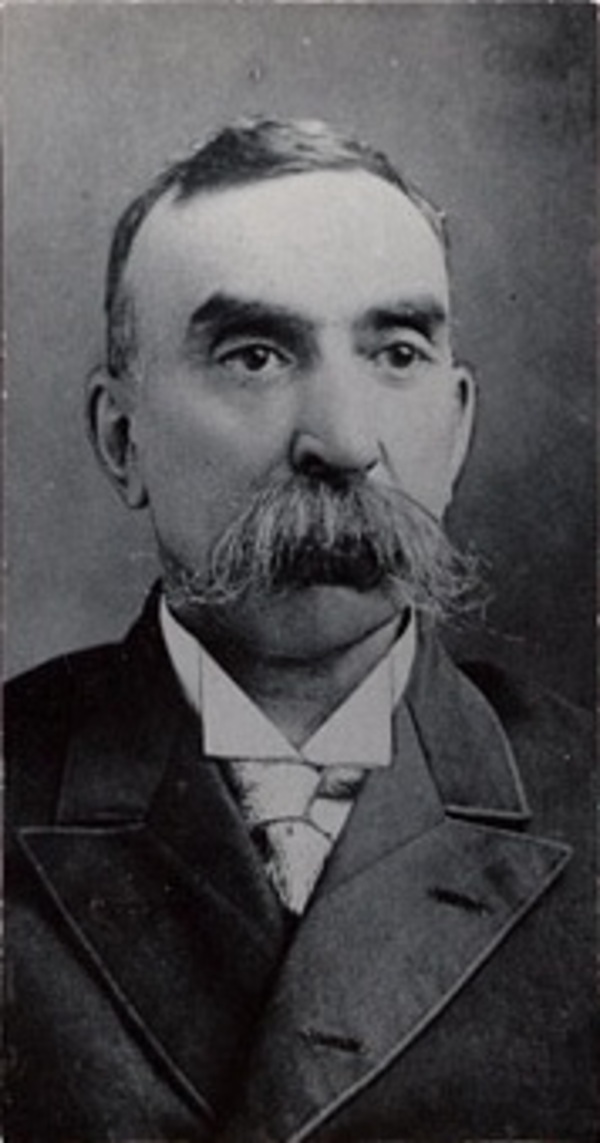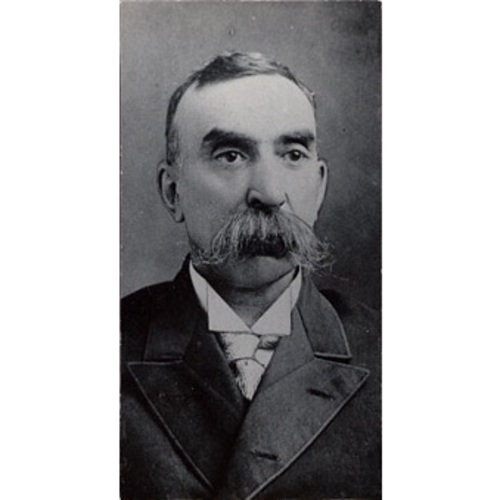
Source: Courtesy of Wikimedia Commons
GAUDET, PLACIDE (he frequently signed Placide P. to signify that he was the son of Placide), teacher, journalist, genealogist, historian, and office holder; b. 19 Nov. 1850 in Dupuis Corner (Cap-Pelé), N.B., son of Placide Gaudet and Marie Vienneau, dit Michaud; m. 14 Nov. 1890 Marie-Rose Arsenault in Egmont Bay, P.E.I., and they had three daughters, two of whom died before reaching adulthood, and one son; d. 9 Nov. 1930 in Shediac, N.B.
Placide Gaudet’s father had died in a fight a few months before he was born, so his mother returned to her father’s farm where she, and later her son, worked. Gaudet attended the local school and he developed an interest in Acadian genealogy and history through listening to his grandfather. In January 1862 his mother moved to her father-in-law’s farm in Dorchester. When the College of St Joseph opened in nearby Memramcook two years later, Gaudet was one of its first students. His mother worked in the kitchen and bakery to pay his fees, and the director, Camille Lefebvre*, took a particular interest in him. After graduating in 1873, Gaudet began to study for the priesthood at the Grand Séminaire de Montréal, but, to the great disappointment of his mother, he was advised to leave by John Sweeny*, the bishop of Saint John, because of ill health. By late November 1874 he had returned to New Brunswick.
On leaving the seminary Gaudet’s lifelong struggle with poverty began, as did the first of several desperate searches for employment. He wrote to friends from college, seeking work in journalism or the civil service, but was forced into a series of short-term teaching posts. These included about a year, 1875–76, at the Académie de Saint-Louis in Saint-Louis de Kent, a brief period in the public schools of Tracadie and Neguac, and a year with the French department of the grammar school in Shediac. During his spare time he enjoyed researching local history and at about this period he contributed the first of many articles to Acadian newspapers. Since advancement to a higher class of teaching licence would mean an increase in pay, Gaudet enrolled in the regular program of the Normal School in Fredericton during the autumn of 1881. He received three of the necessary five progress reports, but withdrew before any average or change in professional standing was allotted to him; he returned to teaching. In the Cocagne region he taught during 1882–83 using the “intuitive method of instruction,” and some parents complained. He left at the end of the term, but not without publishing a vindication in Le Moniteur acadien of Shediac, indicating that Valentin Landry*, then inspector, had found his school in satisfactory condition and had praised his work as “sound and intelligent.” Historian and senator Pascal Poirier* would nevertheless write at Gaudet’s death that he could think of no one less suited to teach the rudiments of education. Gaudet’s plan to have his students collect oral history from the old people of the village was, however, well ahead of its time.
Gaudet’s job search began again. In 1882 he had sought work at the Canadian archives [see Douglas Brymner*], apparently in competition with Poirier. Narcisse Robidoux, a brother of Ferdinand, the editor of Le Moniteur acadien, agreed to support his application if Gaudet could conquer his long-standing difficulty with alcohol. Although Gaudet would continue to struggle with this problem until at least 1901, he obtained a two-year contract (1883–85) with the archives to copy parish registers in Acadian areas. This did not pay the bills, so he took three more short-term teaching jobs and spent an equally short period in Bathurst with the Courrier des provinces Maritimes before becoming the editorial secretary of Le Moniteur acadien during the fall of 1886. From there he moved to L’Évangéline in Weymouth, N.S., where he worked from July 1890 to mid August 1893. In May 1894 he went back to the Courrier des provinces Maritimes and stayed until March 1895. His disputes with colleagues and with contributors who ventured to write Acadian history became notorious.
In August 1895 Gaudet moved to Church Point, N.S., to teach at the new Collège Sainte-Anne [see Gustave Blanche*]. He also continued to research local history. One student, J. E. Belliveau, would remember his talks there on Acadia with interest. He remained until the college burnt down in January 1899. That year he received a full-time contract from the archives to copy registers in the Acadian parishes of Prince Edward Island and New Brunswick. Brymner, the dominion archivist, was dissatisfied with Gaudet’s failure to produce reports of the work he had accomplished. In 1903 only the intervention of friends, including New Brunswick mp John Costigan*, allowed him to keep his job. When Arthur George Doughty* took over the archives in 1904, the two established a good relationship. Gaudet moved to Ottawa to become genealogist at the archives. Under pressure from Doughty, he produced a genealogy of Acadian families over 460 pages long, published in the Report concerning Canadian archives for the year 1905 (Ottawa, 1906). It was his only lengthy publication.
During his years at the archives, where he would remain until 1924, Gaudet continued to collect material from a variety of sources. Much of his time was occupied by correspondence; he replied, often at great length, to numerous queries for information on Acadian genealogy and history. His remarkable contribution to Acadian genealogy, the transcription of an estimated 50,000 entries from parish registers covering the descendants of almost all Acadian families from the 17th to the early 20th century, made him the unquestioned authority on genealogy and provided a basis for Acadians to begin writing their own history rather than relying on scholars from elsewhere. He was also an important source of information for historians such as Pierre-Marie Dagnaud, William Francis Ganong*, Henri-Raymond Casgrain*, John Clarence Webster*, and Émile Lauvrière, as well as for author Margaret Marshall Saunders*. The stories of Acadian experiences, especially during the deportation of 1755, that he had collected and published were always carefully documented. James de Finney views Gaudet’s work as characteristic of a tradition in Acadian literature which attempted to recover scattered fragments of the collective memory. Gaudet’s vitriolic criticisms of the works of others were at times justified, though in the case of his 1911 pamphlet Les données erronées, which pointed out errors in Joseph-Edmond Roy*’s history of Acadian notaries, personal feelings may have sharpened his pen.
Financial pressures and his reluctance to publish what he considered unfinished work meant that Gaudet’s only additional publication was an 84-page booklet entitled Le grand dérangement. Written in 1921 in support of the Acadian proposal to construct a commemorative church at Grand Pré, N.S. [see David-Vital Landry], it was issued the following year by the committee sponsoring the project. Gaudet’s thesis, that the evidence convicted only Governor Charles Lawrence* of responsibility for the deportation of the Acadians, and not the British government, was highly controversial.
In spite of frequent disputes with other authors, Gaudet could be a generous friend and ally. He maintained lifelong ties with many correspondents, including most of the Acadian elite. A founder and member of the Ottawa branch of the Société l’Assomption [see Rémi Benoît*], he was a hospitable and well-liked member of the capital’s Acadian community. He encouraged the establishment of monuments to the Acadian past and gave talks on Acadian history.
In 1924, after he was requested to retire on a monthly pension of $84, he moved to Moncton. The following year, in a letter to his son, he complained of difficulties with his wife, whom he described as suffering from religious mania. At the time of his death, in November 1930, he was living apart from her, in a hospice in Shediac. During his last public appearance a few weeks earlier he had still been eager to share with Acadian children his vast knowledge of the history of their ancestors.
The voluminous Placide Gaudet fonds at the LAC consists of typewritten Acadian genealogies (MG 30, C20, 1-19), notes and subject files on Acadian history as well as extracts from parish registers (C20, 20-28), and about 135,000 index cards on Acadian genealogy (C20, 29-118). The Placide Gaudet fonds at the Centre d’Études Acadiennes, Univ. de Moncton, N.-B., just as imposing, contains documentation on Acadian history, including manuscripts (originals, copies, and transcripts), correspondence (originals and copies), notes, and a number of other materials.
In addition to numerous articles published in the local press, Gaudet is the author of “Acadian genealogy and notes,” in Public Arch. of Canada, Report concerning Canadian archives for the year 1905 (3v., Ottawa, 1906), 2; Les données erronées de monsieur J. Edmond Roy sur les notaires de l’Acadie (Shédiac, N.-B., 1911); and Le grand dérangement: sur qui retombe la responsabilité de l’expulsion des Acadiens (Ottawa, 1922).
Centre d’Études Acadiennes, Fonds du collège Saint-Joseph/univ. de Moncton, 1864–1972, documentation financière, Grand Livre no.1, 1865–78: 33-35; Grand Livre no.1, 1865–84: 1, 9, 22; Fonds Pascal Poirier, 6.1-3; Fonds Valentin Landry, 7.1-2, 7.1-7, 7.1-19. PANB, MC2495, F15653 (mfm.); RS117, A2/2, 1. L’Évangéline (Weymouth Bridge, N.-É.), 31 oct.–12 déc. 1895; (Moncton), 30 mars 1916; 4 mai 1922; 28 avril 1927; 13, 20, 30 nov. 1930. Le Moniteur acadien (Shédiac), 22 mars 1883. Anselme Chiasson, “Placide Gaudet,” Soc. Hist. Acadienne, Cahiers (Moncton), 4 (1971–73): 6–23. C.-A. Doucet, Une étoile s’est levée en Acadie ([Rogersville, N.-B.], 1973). James de Finney, “Du fait divers au récit commun: le rôle littéraire de l’Évangéline,” in ‘L’Évangéline,’ 1887–1982; entre l’élite et le peuple, sous la dir. de Gérard Beaulieu (Moncton, 1997), 135–53. Pierre et P.-M. Gérin, Marichette: lettres acadiennes, 1895-1898 (Québec, 1982). “Histoire de la paroisse de Cap Pelé,” Soc. Hist. de la Mer Rouge, Sur l’empremier (Robichaud, N.-B.), 2 (1986), no.1: 44. René LeBlanc et Micheline Laliberté, Sainte-Anne, collège et université, 1890–1990 (Pointe-de-l’Église [Church Point], N.-É., 1990). J.-M. Leger, “Placide Gaudet,” Soc. Hist. Acadienne, Cahiers, [2] (1966–68): 18–22.
Cite This Article
Sheila Andrew, “GAUDET, PLACIDE (Placide P.),” in Dictionary of Canadian Biography, vol. 15, University of Toronto/Université Laval, 2003–, accessed January 23, 2025, https://www.biographi.ca/en/bio/gaudet_placide_15E.html.
The citation above shows the format for footnotes and endnotes according to the Chicago manual of style (16th edition). Information to be used in other citation formats:
| Permalink: | https://www.biographi.ca/en/bio/gaudet_placide_15E.html |
| Author of Article: | Sheila Andrew |
| Title of Article: | GAUDET, PLACIDE (Placide P.) |
| Publication Name: | Dictionary of Canadian Biography, vol. 15 |
| Publisher: | University of Toronto/Université Laval |
| Year of revision: | 2005 |
| Access Date: | January 23, 2025 |



